
Feb 18-March 18 - The Texas Tropics
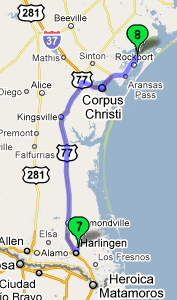 We'd heard a lot of people from up north spend the winter in South Texas, so we figured we owed it to ourselves to check it out. We spent two weeks in Harlingen (7) followed by two weeks in Rockport (8). They are two completely different types of towns. We'd heard a lot of people from up north spend the winter in South Texas, so we figured we owed it to ourselves to check it out. We spent two weeks in Harlingen (7) followed by two weeks in Rockport (8). They are two completely different types of towns.
Harlingen is at the eastern end of the Rio Grande Valley, about 20 miles from Brownsville, the southern-most US city west of the Mississippi. We stayed at a membership park named Tropic Winds, where our "member" rent was just $3 a night. It's been a wet winter in Texas, and when we arrived in Harlingen, we were told that the rainfall so far this winter was more than the total rainfall for the previous 7 winters combined. There'd been a lot of rain just before we arrived, and even the paved sites
were pretty muddy. We parked on the provided concrete patio rather than risk becoming mired in the usual parking space, which was really wet and squishy and showing evidence of previous motorhomes having sunk into the glop. We didn't have hot tropical weather, but we didn't have any frosty mornings either. Most days were shirtsleeve weather. We kind of basked.
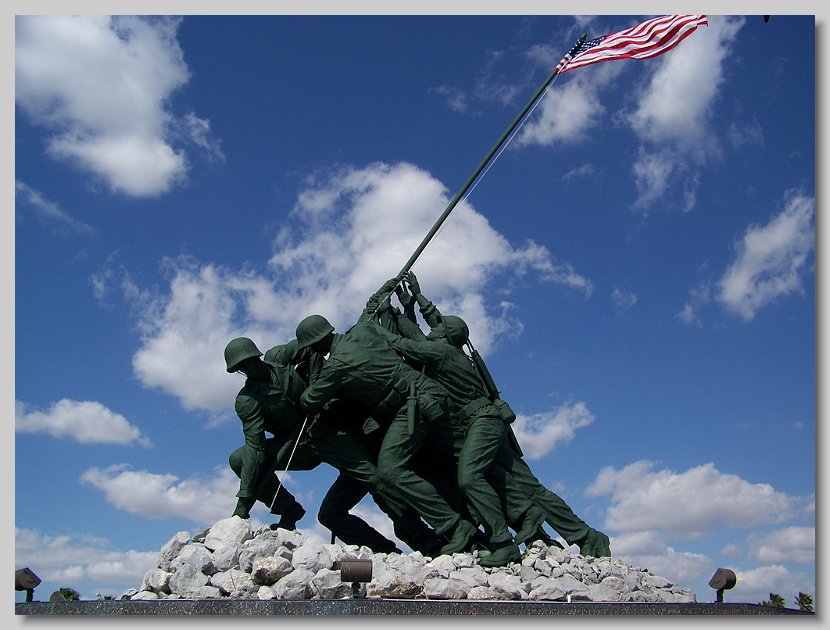 Harlingen is home to the Marine Military Academy, a private military school. The academy, in turn, is home to the Iwo Jima Memorial. The US Marine Corps War Memorial has been a fixture in Washington DC since 1954. But Harlingen has their version. It's the original artist's plaster working model of the bronze memorial statue, depicting the famous WW2 photograph of the raising of the US flag by US Marines on the South
Pacific island of Iwo Jima. The Iwo Jima memorial on the Academy grounds is the original mold used for the casting of the monument now standing at Arlington National Cemetery. After completion of the monument, this full-size plaster sculpture was placed in storage until the early 1980s when its creator donated it to the Marine Military Academy. One of the Marines who participated in the flag raising, a local resident, is buried on the grounds of the Academy, providing an answer to the question "Why here?".
The signage doesn't say how they protect that plaster statue from the elements, but they do say it's an ongoing labor-intensive process. We suspect there's a resin coating over the plaster. In any event, it's very impressive and probably much less crowded than the "official" memorial in Washington. Harlingen is home to the Marine Military Academy, a private military school. The academy, in turn, is home to the Iwo Jima Memorial. The US Marine Corps War Memorial has been a fixture in Washington DC since 1954. But Harlingen has their version. It's the original artist's plaster working model of the bronze memorial statue, depicting the famous WW2 photograph of the raising of the US flag by US Marines on the South
Pacific island of Iwo Jima. The Iwo Jima memorial on the Academy grounds is the original mold used for the casting of the monument now standing at Arlington National Cemetery. After completion of the monument, this full-size plaster sculpture was placed in storage until the early 1980s when its creator donated it to the Marine Military Academy. One of the Marines who participated in the flag raising, a local resident, is buried on the grounds of the Academy, providing an answer to the question "Why here?".
The signage doesn't say how they protect that plaster statue from the elements, but they do say it's an ongoing labor-intensive process. We suspect there's a resin coating over the plaster. In any event, it's very impressive and probably much less crowded than the "official" memorial in Washington.
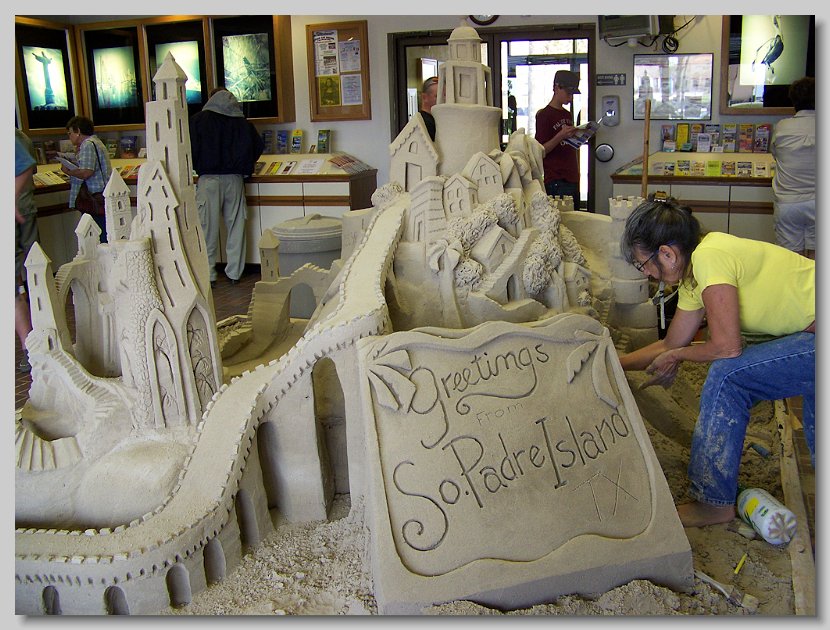 South Padre Island, about 40 miles southeast of Harlingen, is a major spring-break destination, and fortunately we were there well before the invasion. On the one day we visited the island, we managed to see a spectacular sand castle being built, made an obligatory visit to the beach, and toured the wonderful Bird and Nature Sanctuary. South Padre Island, about 40 miles southeast of Harlingen, is a major spring-break destination, and fortunately we were there well before the invasion. On the one day we visited the island, we managed to see a spectacular sand castle being built, made an obligatory visit to the beach, and toured the wonderful Bird and Nature Sanctuary.
Brownsville itself has a very nice smaller zoo - the Gladys Porter Zoo - where we spent a great afternoon. Not particularly spendy, either. Other than that, we kind of stayed close to home. Al started on a project to transfer all of our DVDs and accumulated videos to a media player connected to the TV, so we'd have all our videos always on line and available. Having the DVR functions on our satellite TV receiver has spoiled us for instant access.
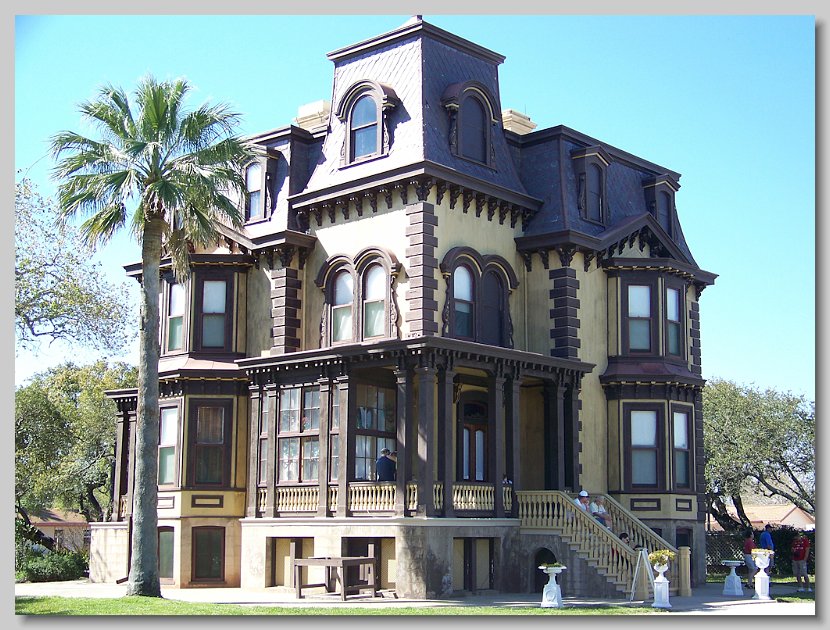 From Harlingen, we moved about 170 miles north to the delightful community of Rockport. So far, the Rockport-Fulton area on the Gulf of Mexico is our best winter stop. It's a resort town, with a Texas flavor. Lots of touristy things to do, plenty of good places to eat (including at least two quite good BBQ places), delightful scenery, and a very nice Presbyterian Church. Among other things, we spent a few hours at
the "world-famous" Fulton Oysterfest, which draws about 30,000 people the first weekend in March. We went to a fun performance of "The Sunshine Boys" at the local
little theater, visited the local aquarium, maritime museum and obligatory historical Victorian mansion, and drove into nearby Corpus Christi to tour the USS Lexington, a retired aircraft carrier. We visited the "Big Tree", reported to be one of the oldest (1200 years) and largest (35ft circumference) Live Oak trees in the world. As someone else looking at the tree pointed out, it doesn't take much to amuse us old folks. From Harlingen, we moved about 170 miles north to the delightful community of Rockport. So far, the Rockport-Fulton area on the Gulf of Mexico is our best winter stop. It's a resort town, with a Texas flavor. Lots of touristy things to do, plenty of good places to eat (including at least two quite good BBQ places), delightful scenery, and a very nice Presbyterian Church. Among other things, we spent a few hours at
the "world-famous" Fulton Oysterfest, which draws about 30,000 people the first weekend in March. We went to a fun performance of "The Sunshine Boys" at the local
little theater, visited the local aquarium, maritime museum and obligatory historical Victorian mansion, and drove into nearby Corpus Christi to tour the USS Lexington, a retired aircraft carrier. We visited the "Big Tree", reported to be one of the oldest (1200 years) and largest (35ft circumference) Live Oak trees in the world. As someone else looking at the tree pointed out, it doesn't take much to amuse us old folks.
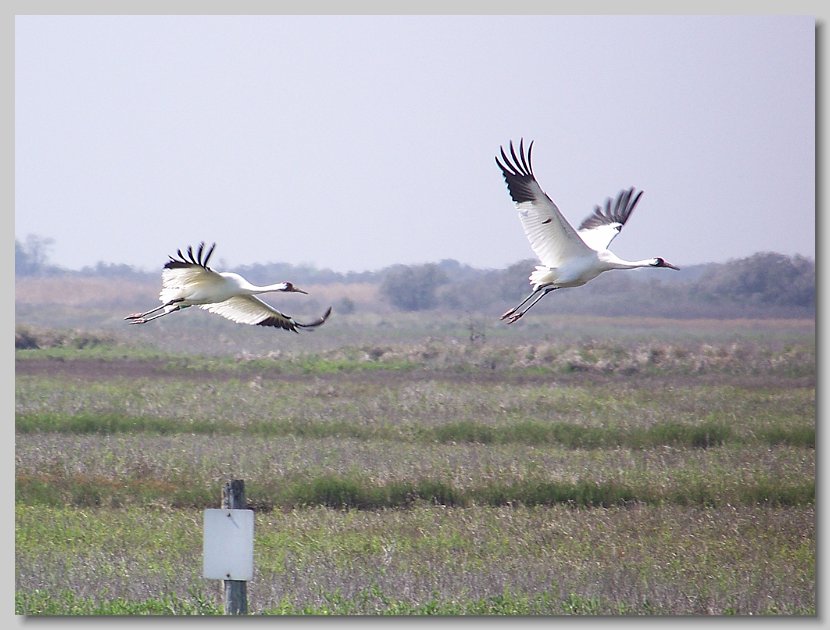 There are fewer than 400 Whooping Cranes left in the wild, and about 2/3 of them spend the winter in the Aransas National Wildlife Refuge, very near Rockport. The birds are making a comeback, having dwindled to just 16 birds in the 1970s, but they're still very much endangered. These are the birds that are trained to migrate by folks with ultra-light airplanes, although those birds go to Florida for the winter.
Whooping Cranes are big birds - about 5ft tall when standing, with an 8ft wingspan. We took a most enjoyable birding boat tour specifically to see the whoopers. We also saw a couple dozen
other species of birds. At one point, as we were watching some Whooping Cranes, the boat captain pointed out that from our position, we could see about 2% of all the Whooping Cranes in the world - there were 9 or 10 of them in sight. That's pretty awesome, and also pretty sobering. This
was a serious bird-watching expedition - there were folks with their log books and spotting scopes and bush jackets, and then there were normal folks like us. The captain was a fountain of information and could identify everything we encountered. We even encountered a pod of Atlantic Bottle-nosed Dolphin, who (which?) thrilled us all by surfing the tour boat wake for several minutes. There are fewer than 400 Whooping Cranes left in the wild, and about 2/3 of them spend the winter in the Aransas National Wildlife Refuge, very near Rockport. The birds are making a comeback, having dwindled to just 16 birds in the 1970s, but they're still very much endangered. These are the birds that are trained to migrate by folks with ultra-light airplanes, although those birds go to Florida for the winter.
Whooping Cranes are big birds - about 5ft tall when standing, with an 8ft wingspan. We took a most enjoyable birding boat tour specifically to see the whoopers. We also saw a couple dozen
other species of birds. At one point, as we were watching some Whooping Cranes, the boat captain pointed out that from our position, we could see about 2% of all the Whooping Cranes in the world - there were 9 or 10 of them in sight. That's pretty awesome, and also pretty sobering. This
was a serious bird-watching expedition - there were folks with their log books and spotting scopes and bush jackets, and then there were normal folks like us. The captain was a fountain of information and could identify everything we encountered. We even encountered a pod of Atlantic Bottle-nosed Dolphin, who (which?) thrilled us all by surfing the tour boat wake for several minutes.
We spent an enjoyable afternoon among the mosquitoes at the Aransas National Wildlife Refuge. Although we'd visited the refuge on the boat ride, there's a whole different experience from the land side. We took a delightful 2+ hour guided tour led by Sharon and Marty Lang, winter volunteers from Indiana, and learned a lot. Never saw any cranes on this tour, but we did see four alligators (some way too close for complete comfort) and some very industrious feral pigs. The bunch of folks in the van were a lot
of fun as well. We also managed a rather impressive collection of mosquito bites - Al many more than Judy, who had the good sense to apply Deet.
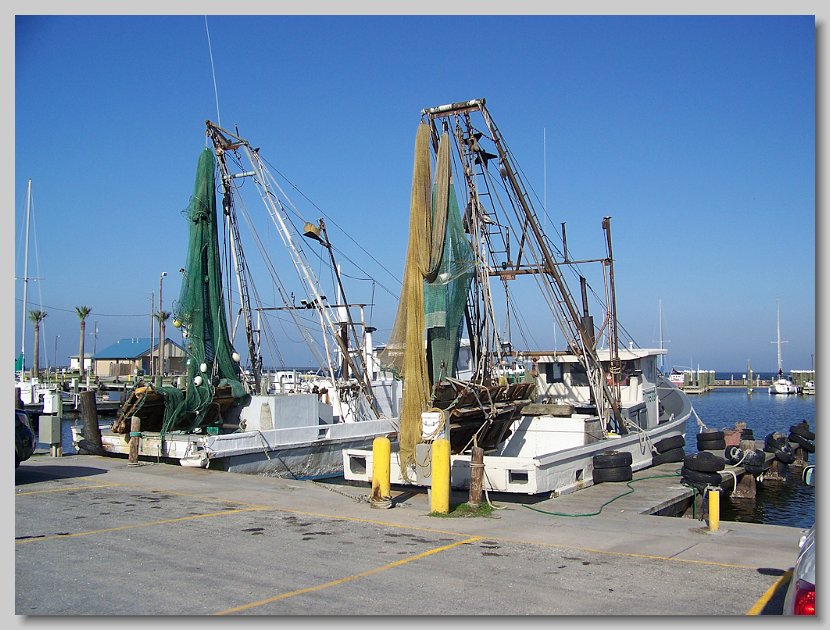 Rockport looks to be a year-round resort, although the winter and summer clientele are probably very different. We know it's mostly snowbirds and old folks in the winter, and we suspect it's mostly younger families in the summer. We encountered two businesses with appealing ideas - The Big Fisherman Seafood place has a weekly Tuesday lunch special - all you can eat chicken fried steak, chicken livers and gizzards
for $2.25, and margaritas for $1. We never did get in, but we did spend some time at the end of a 1-hour waiting line one rainy day before giving up. Also, the local movie
theater - a four-plex - offers free popcorn after 6pm on Tuesdays. Bring your own dish, they said, so we did. Again the waiting line. We suspect the theatre does more business on Tuesdays than any other day. For example, we saw the new "Alice In Wonderland" on a Saturday, the second day it was shown. There were just 6 of us in the theater. We saw "Blind Side" - which had been out almost 3 months - on a "Free Popcorn" Tuesday night, and the theatre was absolutely full. Rockport has
earned a place on our so-far short list of places we'd consider spending a whole winter. Of course, we're not done exploring. And, if we choose to stay longer in Rockport, we'll want to find an RV park with a better system for dealing with rain. The membership park we stayed at had no such system, and the mud was horrific. Rockport looks to be a year-round resort, although the winter and summer clientele are probably very different. We know it's mostly snowbirds and old folks in the winter, and we suspect it's mostly younger families in the summer. We encountered two businesses with appealing ideas - The Big Fisherman Seafood place has a weekly Tuesday lunch special - all you can eat chicken fried steak, chicken livers and gizzards
for $2.25, and margaritas for $1. We never did get in, but we did spend some time at the end of a 1-hour waiting line one rainy day before giving up. Also, the local movie
theater - a four-plex - offers free popcorn after 6pm on Tuesdays. Bring your own dish, they said, so we did. Again the waiting line. We suspect the theatre does more business on Tuesdays than any other day. For example, we saw the new "Alice In Wonderland" on a Saturday, the second day it was shown. There were just 6 of us in the theater. We saw "Blind Side" - which had been out almost 3 months - on a "Free Popcorn" Tuesday night, and the theatre was absolutely full. Rockport has
earned a place on our so-far short list of places we'd consider spending a whole winter. Of course, we're not done exploring. And, if we choose to stay longer in Rockport, we'll want to find an RV park with a better system for dealing with rain. The membership park we stayed at had no such system, and the mud was horrific.
We obviously took a bunch of still pictures during these four weeks, and you just know we have some to share. There are about 133 in our slideshow, which you can find here.
From Rockport, we drove almost due north to the banks of the Colorado River near Columbus TX, and from there to the shores of Lake Conroe, about 40 miles north of Houston. Details of those 3 weeks in our next report.
|

 We'd heard a lot of people from up north spend the winter in South Texas, so we figured we owed it to ourselves to check it out. We spent two weeks in Harlingen (7) followed by two weeks in Rockport (8). They are two completely different types of towns.
We'd heard a lot of people from up north spend the winter in South Texas, so we figured we owed it to ourselves to check it out. We spent two weeks in Harlingen (7) followed by two weeks in Rockport (8). They are two completely different types of towns.